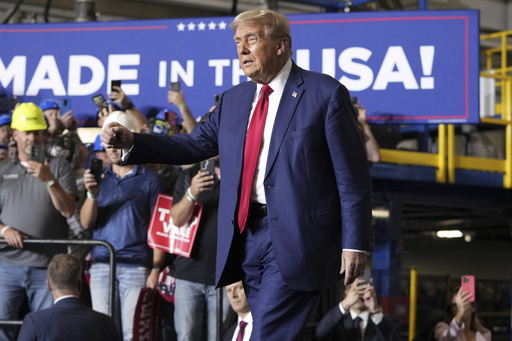
Grand Rapids, Michigan — In a spirited competition for the support of labor unions, Vice President Kamala Harris has been actively engaging with union members in Michigan, a state with deep ties to organized labor. Meanwhile, former President Donald Trump is rallying support from blue-collar workers in rural steel facilities, positioning himself as a defender of their interests.
Both candidates are vying for the allegiance of union workers in Michigan, where the stakes are particularly high for organized labor. At a recent rally in Grand Rapids, United Auto Workers (UAW) President Shawn Fain spoke to a gathering of hundreds, stating that Michigan has become “sacred ground” for labor unions. He emphasized that the American dream was in jeopardy and that unions play a crucial role in safeguarding that dream for workers across the nation.
Harris is set to engage with union members again later this week in Michigan, aiming to extend her appeal beyond traditional Democratic voters. Her campaign is becoming increasingly aware of her challenges in connecting with male voters in key blue wall states like Michigan, Wisconsin, and Pennsylvania. The shift in political dynamics, spurred by economic changes, has her team relying on union endorsements to help mobilize these voters.
However, in a setback for Harris, she did not secure endorsements from two significant unions—the International Association of Firefighters and the International Brotherhood of Teamsters—which had previously backed President Joe Biden in the 2020 election. The Teamsters reported that their decision was influenced by a lack of widespread support for Harris among their vast membership. Historically, the Teamsters have not been strictly aligned with the Democratic Party, having previously supported Republican presidents such as Richard Nixon and Ronald Reagan.
Despite some factions within labor deviating from national leadership, the influence and unity of labor organizations remain crucial for the Democratic Party, which has worked to re-establish unions as a cornerstone of its electoral power. Political analyst Adrian Hemond noted that discussions surrounding unions extend beyond just unionized workers, as many individuals in states like Michigan have personal connections to labor organizations.
Trump has seized upon these union non-endorsements, using them to suggest that everyday workers favor his vision for America. Over recent years, traditionally Democratic Midwestern states have seen a shift toward Republican ideals, often linked to economic issues like deindustrialization and changes in trade policies. Non-college-educated white voters, in particular, have increasingly gravitated toward conservative candidates, influenced by concerns over cultural matters concerning race and gender.
In the heart of the U.S. auto industry, Trump is working to amplify his support among workers by criticizing Harris’s stance on electric vehicle initiatives, claiming they threaten job security. He has attempted to undermine union leaders by disparaging UAW President Fain, even lauding Tesla’s CEO for dismissing striking workers, a move that the UAW argues could intimidate potential unionizers.
Historically, Joe Biden’s narrow victory in Michigan in 2020 was a result of strong backing from union members, who have typically been a reliable voting bloc for Democrats. However, Trump’s 2020 performance highlighted a significant divide along educational and income lines, with non-college-educated white voters tending toward his leadership. Biden received substantial support from nonwhite voters, but tensions have emerged among various demographic groups, particularly Arab Americans in the wake of the administration’s foreign policy in the Israel-Hamas conflict.
As Trump campaigns for the presidency once more, his strategy includes appealing to non-college-educated workers, which may help counteract losses he anticipates among white college-educated voters. Former UAW spokesman Brian Rothenberg pointed out that the challenges Democrats face might not stem from union members themselves but rather from their families who may feel economic pressures.
Harris’s efforts are directed toward reinforcing the message that unions benefit all workers. At a recent Labor Day event in Detroit, she called attention to the advancements labor movements have achieved, such as the establishment of the five-day workweek and essential leave policies. “When union wages go up, everybody’s wages go up,” she affirmed.
With recent settlements for UAW workers at major auto manufacturers, Fain is investing heavily in supporting Harris. He argues that the voting pattern of UAW members has remained consistent in recent elections, with many siding with Democratic candidates. As Biden has taken bold steps by engaging directly with striking workers, including a historic moment where he joined a picket line, Trump has quickly responded in various venues, criticizing the administration’s policies while trying to appeal to disaffected workers.
Union leaders assert that Trump’s previous presidency was not beneficial for workers, noting unfavorable rulings from key labor entities and numerous unfulfilled promises related to job creation. They also highlight accomplishments achieved under Democratic leadership, such as the revival of labor laws, which have historically aided unions in states like Michigan.
As union membership continues to decline, Fain faces a critical task of expanding support beyond his immediate base to ensure a victory for Harris in the upcoming election. He has described this moment as crucial, emphasizing that the outcome of the election will significantly influence the future trajectory for unions and workers.
“This is a generation-defining moment, where we are right now,” Fain declared to Michigan voters. “This election is going to determine where we go.”

